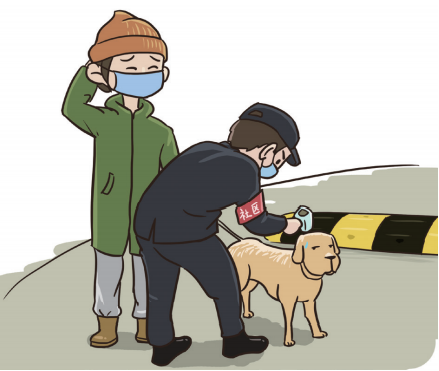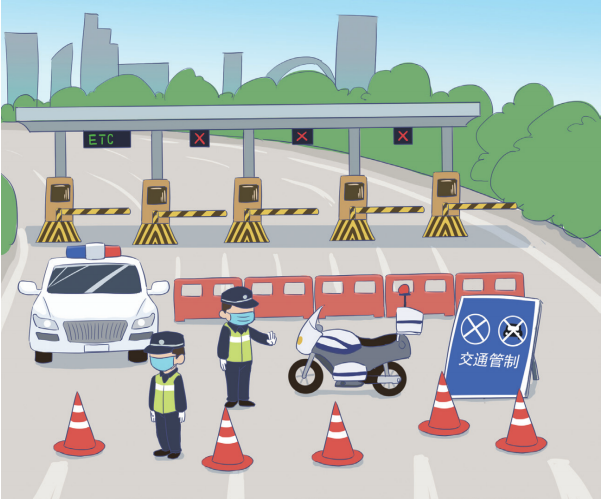


Gu Dasong(Southeast University)
“My city is sick, but I still love it.” -- an excerpt from the lyrics of the song “Wuhaner” created by the people of Wuhan that has moved many people.
“This is my home and we’re gonna protect it. The poem about the Yellow Crane Tower is familiar to every one of us in Wuhan. If it needs me someday, I would give a hand…” This reflects the strong side of the people of Wuhan in the face of a severe epidemic and has encouraged those heading from the rest of the country to help prevent and control the epidemic in Hubei.
However, it’s not enough to combat the epidemic with just a song, as it also requires science and the rule of law. On February 5th 2020, shortly after the outbreak of the epidemic, the Central Commission on Comprehensively Promoting Law-Based Governance issued the Opinions on Preventing and Controlling COVID-19 and Protecting the People, where it’s required to conduct epidemic prevention and control in accordance with laws and regulations, which greatly suppressed illegal acts, such as cutting off roads and sealing off doors of those returning from Hubei.
Many people had no idea what to do about an epidemic that broke out out of blue, as the laws that they used to follow often apply in normal times, which explains why there were still unlawful acts of epidemic prevention and control in multiple areas even though the central government had required law-based epidemic prevention and control, such as the self-declared “wartime regulation” in some places, which rendered the calls for scientific and law-based epidemic prevention and control useless.
As the COVID-19 crisis abates across the country, many started to appeal for production resumption nationwide. But local governments dealt with incoming population with varying approaches. Some governments defined “epidemic hotspots” at their discretion, causing people from the epidemic hotspots refused entry. And some introduced “passcode” with big data, but the problem was: for example, for the same person, his or her passcode was green, meaning he or she hadn’t visited any places of high risk, but it could turn red the next day, which means he or she would be refused entry.
The greatest advantage of a law-based mentality and approach to epidemic prevention and control is that the public would be provided with the explicitness and uniformity of the rule of law. The problem with disrupted production resumption and refusal of entry lies in the lack of a law-based and scientific definition of epidemic hotspots that made it unlikely to offer a law-based guideline to cross-regional traffic flows.
From the perspective of urban governance, a law-based and scientific definition of epidemic hotspots in a city is tantamount to confirmation of an epidemic in the city, which means the authorities would declare that a certain area or the entire city is “sick” and would take measures such as quarantine, disinfection, and treatment to make it “recuperate” when they would rescind the declaration.

Screenshot of a MV for the song “Wuhaner” Photo: Tan Xuan
Authorities legally entitled to define “epidemic hotspots”
There is a common sense in the medical community, which says “doctors cannot be self-treated.” It’s also true with the definition of epidemic hotspots, which, in a legal sense, originates from the requirement that says “nobody can be the judge for his or her own deeds”。
As stipulated in Article 43 of China’s Law on Prevention and Treatment of Infectious Diseases, when an infectious disease under Class A or B breaks out or prevails, local government at or above the county level may, subject to decision by the government at the next higher level, announce part or the whole of its administrative area as an epidemic hotspot, and the State Council may decide and announce areas across provinces, autonomous regions, and municipalities directly under the central government as epidemic hotspots. The procedure of reporting to the government at the next higher level for approval gives the right to decide on defining epidemic hotspots to the government at the next higher level,which is in line with the legal principle that no one can be the judge for his or her own deeds.

Everyone contributes his or her share to epidemic prevention control
But just because of the reporting procedure, the right to report falls to the government that reports, which is similar to transferring the right to preliminary diagnosis to patients themselves in the medical treatment process, which to some extent would lead to the conundrum of one judging oneself. This partly explains why there’s still not a law- based definition of epidemic hotspots in the system of the Law on Prevention and Treatment of Infectious Diseases.
Who should define “epidemic hotspots”?
As economic and social impact and preventative measures to be taken after an epidemic need to be taken into account, defining epidemic hotspots is supposed to be a responsibility of the government. That’s why the government is given the right to report and the government at the next higher level to decide as enshrined in the Law on Prevention and Treatment of Infectious Diseases. But the government is not expert in either diagnosing diseases or identifying what type of infectious diseases they belong to, which has to be done by clinical and public health specialists. And in this sense, it would be a matter of science.
As specified in Article 40 of the Law on Prevention and Treatment of Infectious Diseases, when finding epidemic situation of infectious diseases or receiving reports on such situation, the disease prevention and control institutions shall make epidemiological investigation on the epidemic situation of infectious diseases and based on the findings after such investigation, put forth proposals for defining epidemic hotspots, offer sanitary treatment to the contaminated places, keep the persons in close contact under medical observation at designated places and take other necessary preventive measures, and propose plans for control of the epidemic situation to health administration departments. This gives disease prevention and control institutions the right to propose the definition of epidemic hotspots, which essentially reveals the trust of the legislature in the scientific capacity of professional institutions and their legal right to propose definition of epidemic hotspots.
Similar stipulations can also be found in the Regulations on Public Health Emergencies promulgated and entered into force in 2003. According to Article 26 of the Regulations, after an emergency occurred, health authorities
shall organize experts to conduct a comprehensive assessment to have a preliminary judgement of its type and propose the suggestion on whether or not to implement an emergency response plan. The suggestion specified in the Article shall also be understood as the conclusion put forward by experts based on their scientific expertise that shall be respected.

Off limits Photo: Wu Dan
Instead of allowing two governments at different levels to have a comprehensive diagnosis of the economy and society, the existing Law on Prevention and Treatment of Infectious Diseases follows the basic legal principle of no one judging his or her own deeds by giving the right to decide the definition of epidemic hotspots to the government at the next higher level where an epidemic occurs and giving professional institutions the right to recommend the definition of epidemic hotspots, which reflects the combination of law and science. In this sense, the conundrum of giving the right to report the definition of epidemic hotspots to the government at the lower level would be solved if the right to report is taken as more of a formality rather than has any real effect. In other words, disease prevention and control institutions shall provide recommendations on definition of epidemic hotspots based on professional and independent research, and the government where an epidemic occurs shall coordinate with the government at the next higher level to launch the reporting procedure which however shall not cause any substantive alterations to the suggestion presented by professional institutions. Only with this can we have a clear division of responsibilities and a synergy between professional institutions and the government that help deliver a law-based and scientific response to any outbreaks of major infectious diseases.
Statutory force of defining epidemic hotspots
In China, declaring a city or a certain area of a city an epidemic hotspot, is similar to declaring to a patient diagnostic confirmation and the need for hospitalization.At this time, the patient needs to rest in bed and gets treated in hospital. Similarly, any city or any part of it declared an epidemic hotspot needs to be “hospitalized for treatment” as well. Hence, according to the Law on Prevention and Treatment of Infectious Diseases, declaring an epidemic hotspot, in a legal sense, implies imposed and self-imposed restrictions of what people can do.
Local governments at the county level or above can adopt the emergency measures within an epidemic hotspot specified in Article 42 of the Law on Prevention and Treatment of Infectious Diseases, and quarantine people, supplies, and means of transport coming in and out of the epidemic hotspot. Government of a province, an autonomous region, or a municipality directly under the central government can decide to seal off epidemic hotspots of Class A infectious diseases within its administrative region, but it has to be decided by the State Council to block epidemic hotspots within a large or mediumsized city, those spanning across provinces, autonomous regions or municipalities under the central government, or those whose blockade would lead to traffic disruptions of trunk roads or national border closures. Lifting blockade of epidemic hotspots has to be decided and declared by the same authorities that declared the blockade. This is an explicit legal requirement of restricting an epidemic hotspot following the declaration of defining the epidemic hotspot, which is two-fold: local governments at the county level or above can either adopt the measures specified in Article 42 of the Law on Prevention and Treatment of Infectious Diseases or impose blockade (also known as lockdown in a more informal way)。
But an epidemic hotspot has to be declared before blockade can be imposed. As no cities including Wuhan hit hardest by COVID-19 have been declared epidemic hotspots, the stringent traffic controls imposed in Wuhan and other cities cannot be deemed blockade as specified in the Law on Prevention and Treatment of Infectious Diseases. And in a semantic sense, blockade literally indicates more of a seal-off imposed from the outside, that is, an imposed restriction, but the traffic controls introduced by the Wuhan Municipal Government (the Command Center for Epidemic Prevention and Control) were the kind of seal-off from inside out, namely a self-imposed restriction. As the two are significantly different, the traffic controls are not the legally-defined blockade.
The controls imposed by local authorities are not in accordance with the procedures to be followed after definition of epidemic hotspots as specified in the Law on Prevention and Treatment of Infectious Diseases, but in effect indicate what Article 49 of the Emergency Response Law specifies a series of emergency responses made by the government in execution of its duty following the outbreak of a public health incident, including swift control of sources of danger, marking dangerous zones, sealing off dangerous places, caution areas, and traffic controls.
In a nutshell, the Law of Prevention and Treatment of Infectious Diseases applies to increased controls following definition of epidemic hotspots, while the Emergency Response Law applies to emergency response based on the level of an emergency. Thanks to the gap between the two, it’s been difficult to start defining epidemic hotspots, which has led to disrupted production resumption and refusal of entry. Going forward, lessons shall be learnt to identify the fundamental differences between the two laws and fill the gap by revising them.